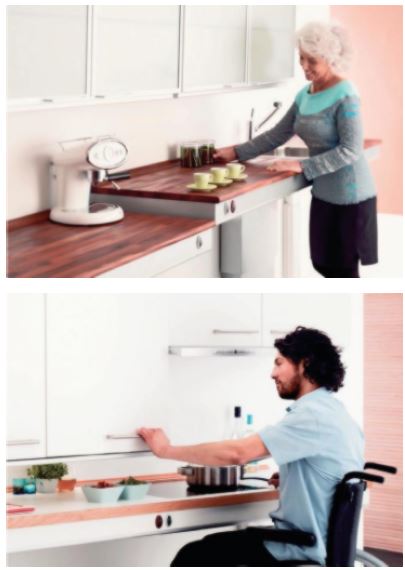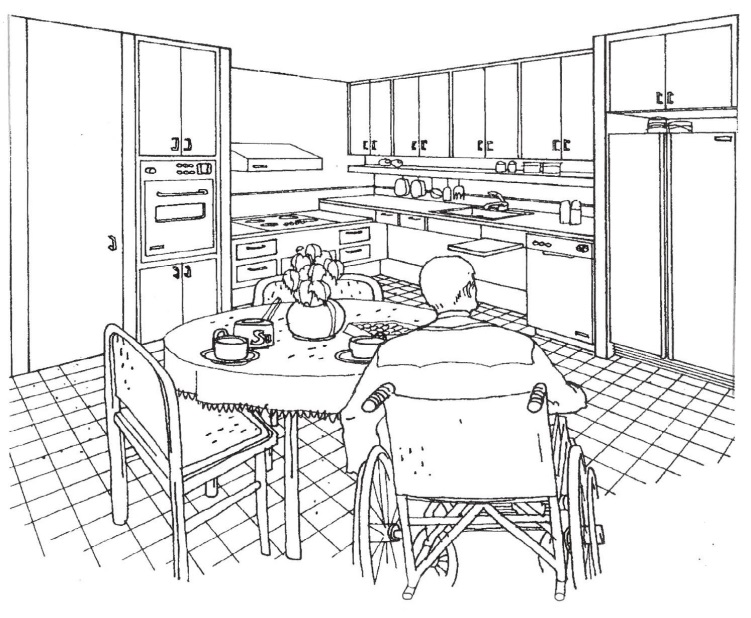Prefabricated under cabinet units with casters are available in the marketplace.
Overhead cabinets: Generally, upper cabinets do not work well since they are not fully accessible.
Accessibility Options: Sliding rails/accessories are available in the marketplace able for integration into the design and fabrication to facilitate cabinets to be height adjustable with the push of a button located at the face of the counter. Prefabricated overhead cabinets are available in the marketplace.
SMART HOME POSSIBILITIES
Barrier free accessibility in the home environment is greatly enhanced with the integration of smart home technology. Latest innovations in technology have facilitated wireless access/control and monitoring of our home environment, including lights, temperature, security, appliances, fixtures, and equipment. Many of these can be implemented in existing homes.
Most available devices offer smart-home integration with systems such as Amazon Alexa, Apple HomeKit, Google Assistant, SmartThings, etc. This allows the linking together of devices from different manufacturers. This includes sensors that allow a smart bulb to go on active mode when someone approaches the front
door, or turn the temperature down when someone leaves a room. However, for simplicity, it is advisable to stay with one platform and manufacturer for compatibility and ease of programming.
SUMMARY
Private homes sometimes require alterations to meet the needs of individuals with disabilities. This process is best accomplished with the assistance of architects and contractors who have experience in these types of renovations. It is my hope that this article provides some helpful information to guide homeowners through the process of making their homes more accessible and accommodating to the special needs of individuals living therein. •
ABOUT THE AUTHOR:
Ramesh Gulatee, LifeCare Design Studio, LLC is an Illinois-based architect with focus on home accessibility. Ramesh has NCARB certification enabling him to work on numerous residential, housing and educational projects across USA. Ramesh has been involved in peer reviews, accessibility audits, and preparation of recommendation reports for Chicago, NY Public Schools and other private sector projects. His know-how is recognized by the regulatory, and professional bodies where he is appointed as an accessibility specialist and serves on various advisory boards and working groups at state and national levels. Contact information: rgulatee@lifecaredesignstudio.com lifecaredesignstudio.com

FOOD FOR THOUGHT: Accessible kitchens utilize adjustable height countertops and upper cabinets within reach of all users.

TYPICAL EXAMPLE OF AN ACCESSIBLE KITCHEN
- Wall oven, for easy access, open at counter height
- Cooktop controls at the front to avoid burning
- Cooktop and counter max. 34" height
- Knee space under sink counter to allow sitting in wheelchair at counter
- High recessed base under cabinets to accommodate wheelchair pedals
- Pullout work shelf
- Mixing faucet at sink, level handle
- Cove lighting under wall cabinets, bulb replacement within reach
- Shallow shelf over sink counter within reach range
- Wall space within reach over sink counter, used for hanging utensils
- Front loading dishwasher
- Side-by-side refrigerator doors to allow access to refrigerator and freezer
- Full height storage cabinet for easy access
- Cabinet space under wall oven within reach range
- Drawers under cooktop and counter for easier access
- Easy grip cabinet door
- High cabinets for non-chairbound users
- Smooth non-skid flooring, open space for wheelchair passage and maneuvering
- Round table to avoid corners, legs or pedestal base with no apron to allow for wheelchair